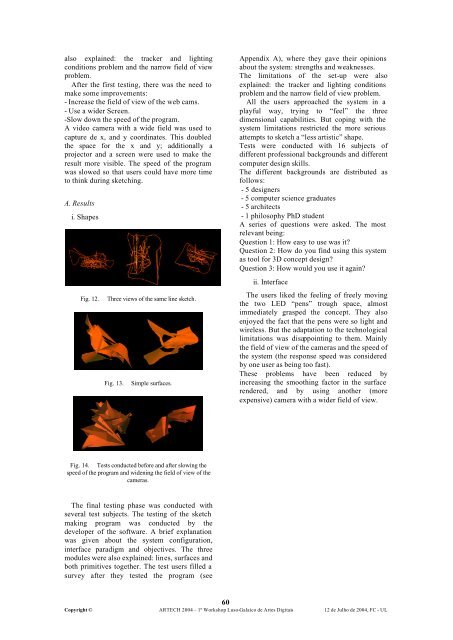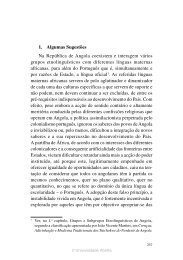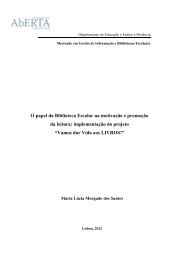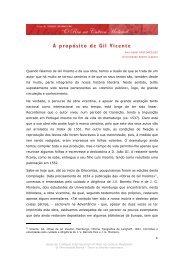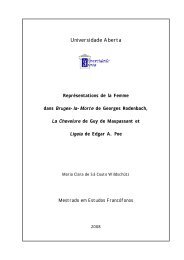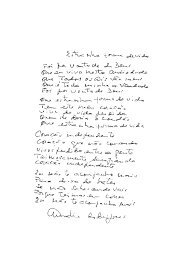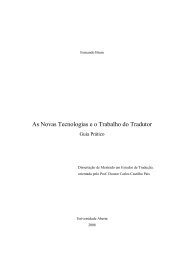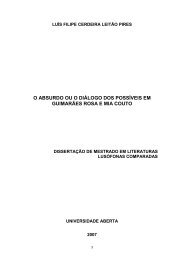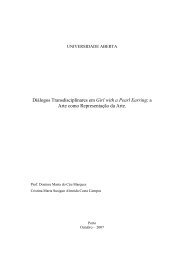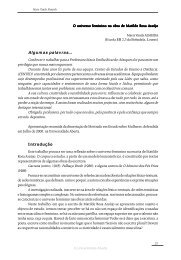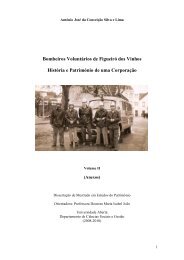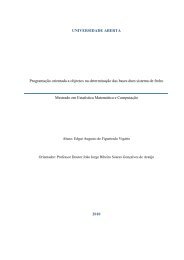NA SENDA DA IMAGEM A Representação ea Tecnologia na Arte
NA SENDA DA IMAGEM A Representação ea Tecnologia na Arte
NA SENDA DA IMAGEM A Representação ea Tecnologia na Arte
Create successful ePaper yourself
Turn your PDF publications into a flip-book with our unique Google optimized e-Paper software.
also explained: the tracker and lighting<br />
conditions problem and the <strong>na</strong>rrow field of view<br />
problem.<br />
After the first testing, there was the need to<br />
make some improvements:<br />
- Incr<strong>ea</strong>se the field of view of the web cams.<br />
- Use a wider Screen.<br />
-Slow down the speed of the program.<br />
A video camera with a wide field was used to<br />
capture de x, and y coordi<strong>na</strong>tes. This doubled<br />
the space for the x and y; additio<strong>na</strong>lly a<br />
projector and a screen were used to make the<br />
result more visible. The speed of the program<br />
was slowed so that users could have more time<br />
to think during sketching.<br />
A. Results<br />
i. Shapes<br />
Fig. 12. Three views of the same line sketch.<br />
Fig. 13. Simple surfaces.<br />
Fig. 14. Tests conducted before and after slowing the<br />
speed of the program and widening the field of view of the<br />
cameras.<br />
The fi<strong>na</strong>l testing phase was conducted with<br />
several test subjects. The testing of the sketch<br />
making program was conducted by the<br />
developer of the software. A brief expla<strong>na</strong>tion<br />
was given about the system configuration,<br />
interface paradigm and objectives. The three<br />
modules were also explained: lines, surfaces and<br />
both primitives together. The test users filled a<br />
survey after they tested the program (see<br />
Appendix A), where they gave their opinions<br />
about the system: strengths and w<strong>ea</strong>knesses.<br />
The limitations of the set-up were also<br />
explained: the tracker and lighting conditions<br />
problem and the <strong>na</strong>rrow field of view problem.<br />
All the users approached the system in a<br />
playful way, trying to “feel” the three<br />
dimensio<strong>na</strong>l capabilities. But coping with the<br />
system limitations restricted the more serious<br />
attempts to sketch a “less artistic” shape.<br />
Tests were conducted with 16 subjects of<br />
different professio<strong>na</strong>l backgrounds and different<br />
computer design skills.<br />
The different backgrounds are distributed as<br />
follows:<br />
- 5 designers<br />
- 5 computer science graduates<br />
- 5 architects<br />
- 1 philosophy PhD student<br />
A series of questions were asked. The most<br />
relevant being:<br />
Question 1: How <strong>ea</strong>sy to use was it?<br />
Question 2: How do you find using this system<br />
as tool for 3D concept design?<br />
Question 3: How would you use it again?<br />
ii. Interface<br />
The users liked the feeling of freely moving<br />
the two LED “pens” trough space, almost<br />
immediately grasped the concept. They also<br />
enjoyed the fact that the pens were so light and<br />
wireless. But the adaptation to the technological<br />
limitations was disappointing to them. Mainly<br />
the field of view of the cameras and the speed of<br />
the system (the response speed was considered<br />
by one user as being too fast).<br />
These problems have been reduced by<br />
incr<strong>ea</strong>sing the smoothing factor in the surface<br />
rendered, and by using another (more<br />
expensive) camera with a wider field of view.<br />
60<br />
Copyright © ARTECH 2004 – 1º Workshop Luso-Galaico de <strong>Arte</strong>s Digitais 12 de Julho de 2004, FC - UL


